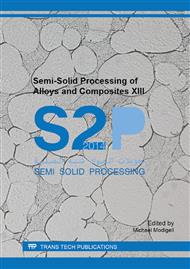p.431
p.436
p.442
p.450
p.455
p.461
p.471
p.481
p.487
SSM Provides Important Advantages; So, why has SSM Failed to Achieve Greater Market Share?
Abstract:
Semi solid metal processing has numerous technical and economic advantages, such as viscous, non-turbulent flow (thus no air entrapment during casting), ability to fill ultra-thin sections (thus reduced part weight), little solidification shrinkage in the die (thus little or no porosity), minimum heat imparted to tooling (thus long tool life) and good response to T-5 aging (thus reduced heat treating costs). Still, SSM has never achieved a prominent position in the field of light metals casting Why Perhaps the reason was largely the down economy of recent years and SSM will yet emerge with the prominence once expected of it.
Info:
Periodical:
Pages:
481-486
Citation:
Online since:
September 2014
Authors:
Keywords:
Price:
Сopyright:
© 2015 Trans Tech Publications Ltd. All Rights Reserved
Share:
Citation:


